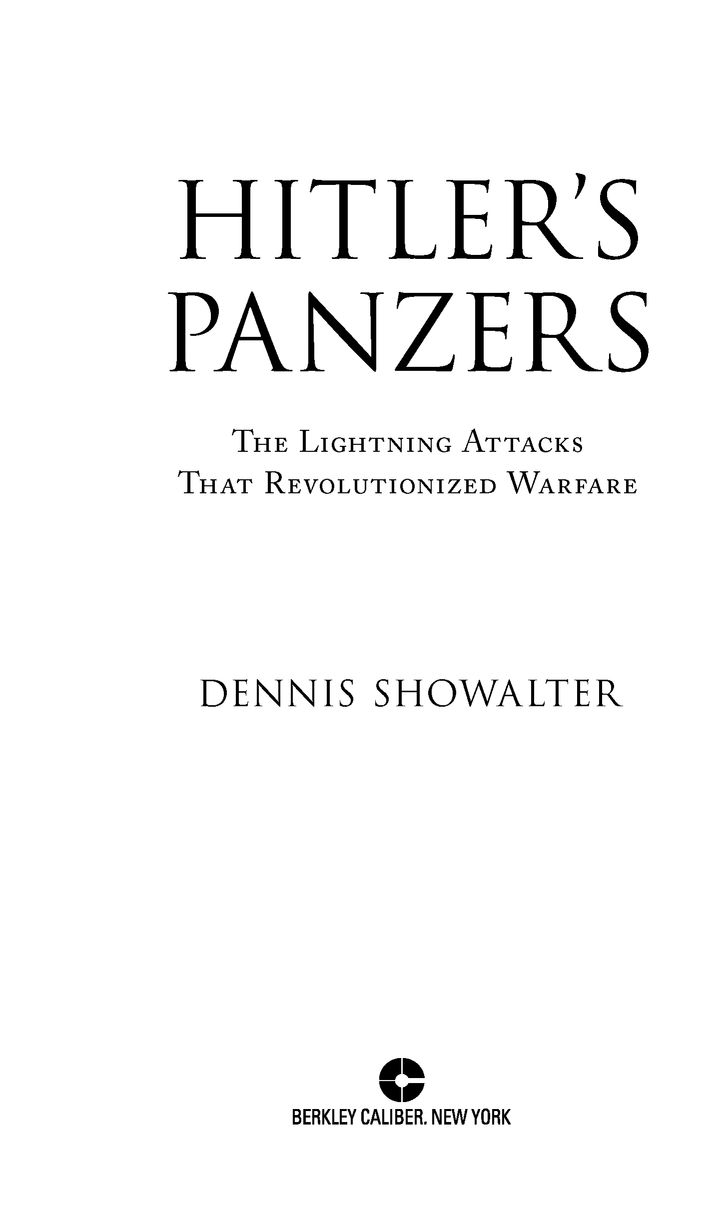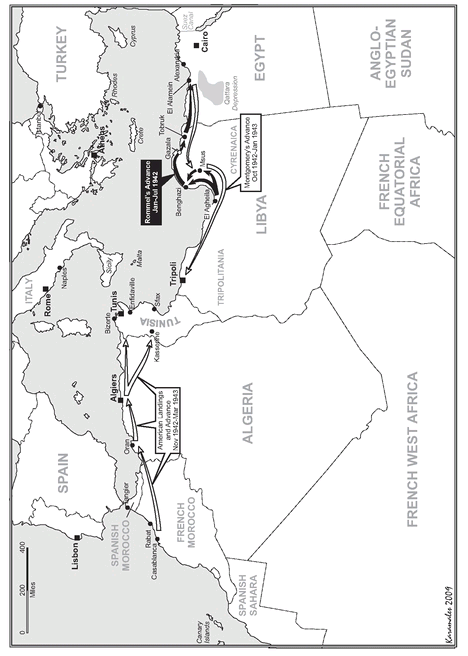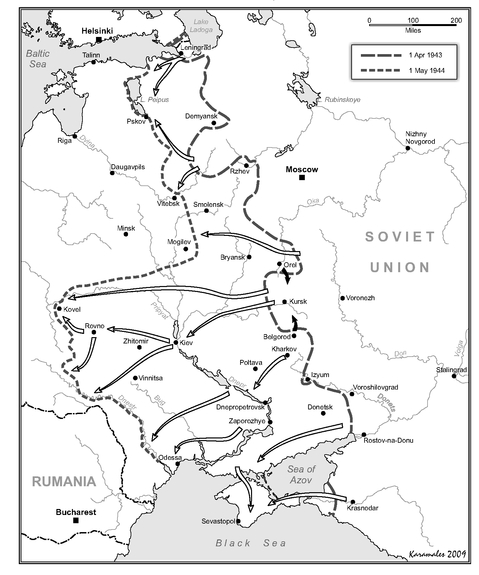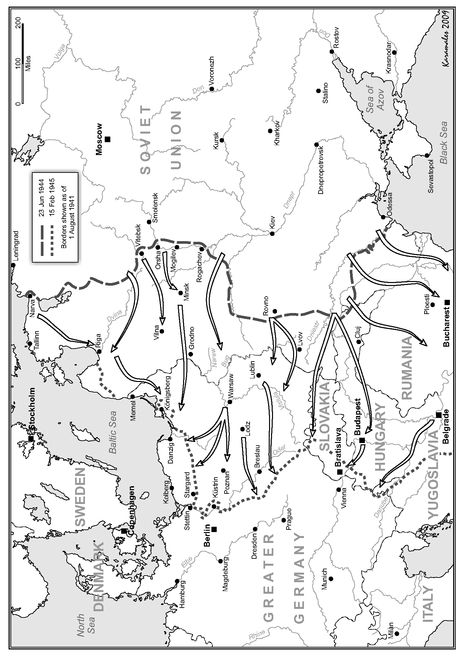Hitler's Panzers
Authors: Dennis Showalter


Table of Contents

THE BERKLEY PUBLISHING GROUP
Published by the Penguin Group
Penguin Group (USA) Inc., 375 Hudson Street, New York, New York 10014, USA
Penguin Group (Canada), 90 Eglinton Avenue East, Suite 700, Toronto, Ontario M4P 2Y3, Canada
(a division of Pearson Penguin Canada Inc.)
Penguin Books Ltd., 80 Strand, London WC2R 0RL, England
Penguin Group Ireland, 25 St. Stephen’s Green, Dublin 2, Ireland (a division of Penguin Books Ltd.)
Penguin Group (Australia), 250 Camberwell Road, Camberwell, Victoria 3124, Australia
(a division of Pearson Australia Group Pty. Ltd.)
Penguin Books India Pvt. Ltd., 11 Community Centre, Panchsheel Park, New Delhi—110 017, India
Penguin Group (NZ), 67 Apollo Drive, Rosedale, North Shore 0632, New Zealand
(a division of Pearson New Zealand Ltd.)
Penguin Books (South Africa) (Pty.) Ltd., 24 Sturdee Avenue, Rosebank, Johannesburg 2196,
South Africa
Published by the Penguin Group
Penguin Group (USA) Inc., 375 Hudson Street, New York, New York 10014, USA
Penguin Group (Canada), 90 Eglinton Avenue East, Suite 700, Toronto, Ontario M4P 2Y3, Canada
(a division of Pearson Penguin Canada Inc.)
Penguin Books Ltd., 80 Strand, London WC2R 0RL, England
Penguin Group Ireland, 25 St. Stephen’s Green, Dublin 2, Ireland (a division of Penguin Books Ltd.)
Penguin Group (Australia), 250 Camberwell Road, Camberwell, Victoria 3124, Australia
(a division of Pearson Australia Group Pty. Ltd.)
Penguin Books India Pvt. Ltd., 11 Community Centre, Panchsheel Park, New Delhi—110 017, India
Penguin Group (NZ), 67 Apollo Drive, Rosedale, North Shore 0632, New Zealand
(a division of Pearson New Zealand Ltd.)
Penguin Books (South Africa) (Pty.) Ltd., 24 Sturdee Avenue, Rosebank, Johannesburg 2196,
South Africa
Penguin Books Ltd., Registered Offices: 80 Strand, London WC2R 0RL, England
This book is an original publication of The Berkley Publishing Group.
The publisher does not have any control over and does not assume any responsibility for author or third-party websites or their content.
All rights reserved.
No part of this book may be reproduced, scanned, or distributed in any printed or electronic form without permission. Please do not participate in or encourage piracy of copyrighted materials in violation of the author’s rights. Purchase only authorized editions.
BERKLEY CALIBER and its logo are trademarks of Penguin Group (USA) Inc.
Library of Congress Cataloging-in-Publication Data
Showalter, Dennis E.
Hitler’s Panzers : the lightning attacks that revolutionized warfare / Dennis Showalter.
p. cm.
Includes index.
Hitler’s Panzers : the lightning attacks that revolutionized warfare / Dennis Showalter.
p. cm.
Includes index.
eISBN : 978-1-101-15168-6
1. Germany. Heer—Armored troops—History—20th century. 2. Tanks (Military science)—
Germany-—History—20th century. 3. World War, 1939-1945—Tank warfare. 4. World War,
1939-1945—Germany. 5. Hitler, Adolf, 1889-1945—Military leadership. 6. Lightning war—
Germany—History—20th century. 7. Military art and science—Germany—History—20th century.
I. Title.
D757.54.S56 2009
940.54’1343—dc22
2009017551
Germany-—History—20th century. 3. World War, 1939-1945—Tank warfare. 4. World War,
1939-1945—Germany. 5. Hitler, Adolf, 1889-1945—Military leadership. 6. Lightning war—
Germany—History—20th century. 7. Military art and science—Germany—History—20th century.
I. Title.
D757.54.S56 2009
940.54’1343—dc22
2009017551
GERMAN CAMPAIGN IN THE WEST, 1940

GERMAN INVASION OF SOVIET UNION, 1941-1942

CAMPAIGNS IN NORTH AFRICA

EASTERN FRONT, 1943-1944

THE EASTERN FRONT, 1944-1945

INTRODUCTION
T
HE GERMAN ARMY of World War II continues to attract reader attention. Academic studies and military analyses, general-reader narratives and coffee-table picture books, all jostle for places in book stores and on bookshelves. Central to history and myth alike are the armored forces: the tanks and assault guns, the motorized infantry, and the supporting arms of the panzer and panzer grenadier divisions of the army and the Waffen SS. They were the heart of the army’s fighting power and the core of its identity from the first days of victory in 1939 until the Third Reich’s downfall in 1945.
HE GERMAN ARMY of World War II continues to attract reader attention. Academic studies and military analyses, general-reader narratives and coffee-table picture books, all jostle for places in book stores and on bookshelves. Central to history and myth alike are the armored forces: the tanks and assault guns, the motorized infantry, and the supporting arms of the panzer and panzer grenadier divisions of the army and the Waffen SS. They were the heart of the army’s fighting power and the core of its identity from the first days of victory in 1939 until the Third Reich’s downfall in 1945.
The panzers have inspired a correspondingly rich literature. Works on doctrine, tactics, and equipment stand alongside studies of the panzers’ place in the German way of war and the history of war in the twentieth century. In darker contexts scholars present the panzers’ contributions to an ethic of fear and force that permeated Germany and its army before the rise of National Socialism transformed apocalyptic ideology into genocidal reality.
General, comprehensive discussions of Hitler’s panzers have been understandably lacking. This book puts panzers at the center of three interfacing narratives. It presents the panzers’ contributions to the development of mechanized war and armor technology, their influence on the role of the army in German culture and society, and their role in the Third Reich’s conduct of World War II—militarily and morally.
The massive body of printed and archival sources available on each of these subjects can provide a multiple-entry footnote for every paragraph and for many individual sentences. I have appealed to reader-friendliness, eschewing a reference apparatus in favor of occasionally naming someone whose contribution to a particular issue demands acknowledgment. For simplicity’s sake I have taken several other shortcuts as well. German ranks are given in American equivalents—including the mouth-filling titles of the Waffen SS. I reduce to a minimum the italicization of already complex German vehicle and weapons designations. All units of all armies follow the same terminology unless otherwise noted. Thus British or French armored units titled squadrons and regiments usually become companies and battalions.
The consistent use of “approximately” and “about” when giving vehicle strengths in particular reflects the fact that those numbers often varied widely, literally from day to day, given the effectiveness of the workshops and recovery crews. Exact statistics are correspondingly likely to mislead—which was not infrequently the intention of compilers seeking to increase their inventory by exaggerating shortages.
This is a story as much as a history. It is shaped by research and by four decades’ worth of memories and anecdotes acquired from listening to the men who were there on both sides. It addresses deeds and behaviors that defy conventional explanations, positive and negative. In the kaleidoscope that was the Third Reich, the same institutions, the same persons, the same man, could show a near-random set of faces. Which were masks and which realities? Throughout this project I have sought counsel from another soldier, who asks that when his story is told, “nothing extenuate, nor set down aught in malice.” In telling the tale of Hitler’s panzers, there are worse mentors than Othello.
Authors’ acknowledgments are tending to match those of the Academy Awards in length and fulsomeness. Without intending to slight anyone, I thank the students of Colorado College, who after over forty years keep me having too much fun to retire. And I thank especially the office staff of the history department: Sandy Papuga and Joanna Popiel. The book is dedicated to them, for more reasons than they know.
CHAPTER ONE
BEGINNINGS
S
EPTEMBER 15, 1916, began as a routine day for the German infantrymen in the forward trenches around Flers on the Somme—as routine as any day was likely to be after two and a half months of vicious, close-gripped fighting that bled divisions white and reduced battalions to the strength of companies. True, an occasional rumble of engines had been audible across the line. But the British had more trucks than the Kaiser’s army, and were more willing to risk them to bring up ammunition and carry back wounded. True, there had been occasional gossip of something new up Tommy’s sleeve: of armored “land cruisers” impervious to anything less than a six-inch shell. But rumors—Scheisshausparolen in Landser speak—were endemic on the Western Front. Then “a forest of guns opened up in a ceaseless, rolling thunder, the few remaining survivors . . . fight on until the British flood overwhelms them, consumes them, and passes on. . . . An extraordinary number of men. And there, between them, spewing death, unearthly monsters: the first British tanks.”
EPTEMBER 15, 1916, began as a routine day for the German infantrymen in the forward trenches around Flers on the Somme—as routine as any day was likely to be after two and a half months of vicious, close-gripped fighting that bled divisions white and reduced battalions to the strength of companies. True, an occasional rumble of engines had been audible across the line. But the British had more trucks than the Kaiser’s army, and were more willing to risk them to bring up ammunition and carry back wounded. True, there had been occasional gossip of something new up Tommy’s sleeve: of armored “land cruisers” impervious to anything less than a six-inch shell. But rumors—Scheisshausparolen in Landser speak—were endemic on the Western Front. Then “a forest of guns opened up in a ceaseless, rolling thunder, the few remaining survivors . . . fight on until the British flood overwhelms them, consumes them, and passes on. . . . An extraordinary number of men. And there, between them, spewing death, unearthly monsters: the first British tanks.”
Other books
'Til Grits Do Us Part by Jennifer Rogers Spinola
Ladies Coupe by Nair, Anita
Cupcakes and Killer Heels by Heidi Rice
Recon Marines II: Marine's Heiress, The by Susan Kelley
Widow of Gettysburg by Jocelyn Green
Magic of Home: an Uncollected Anthology story by Reed, Annie
Strange but True by John Searles
The Princess Who Tamed Demons by J. Kirsch
Marihuana by Cornell Woolrich
Limassol by Yishai Sarid
